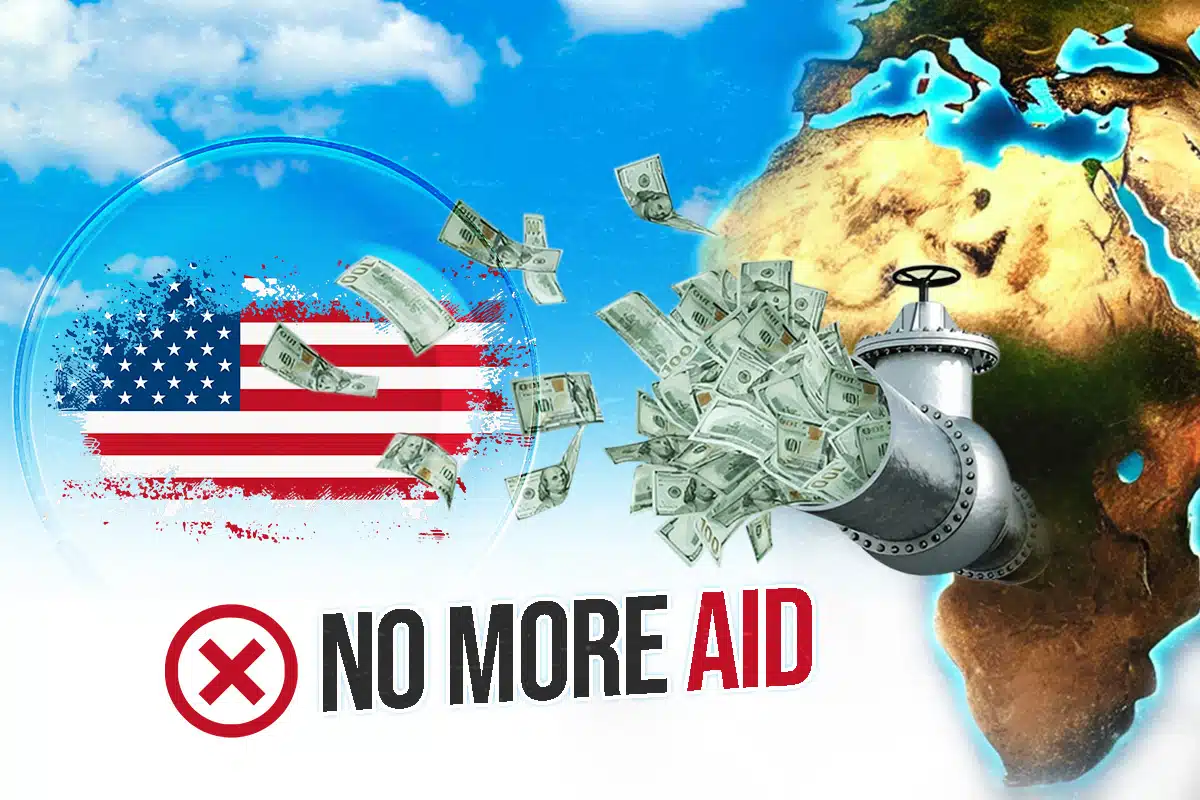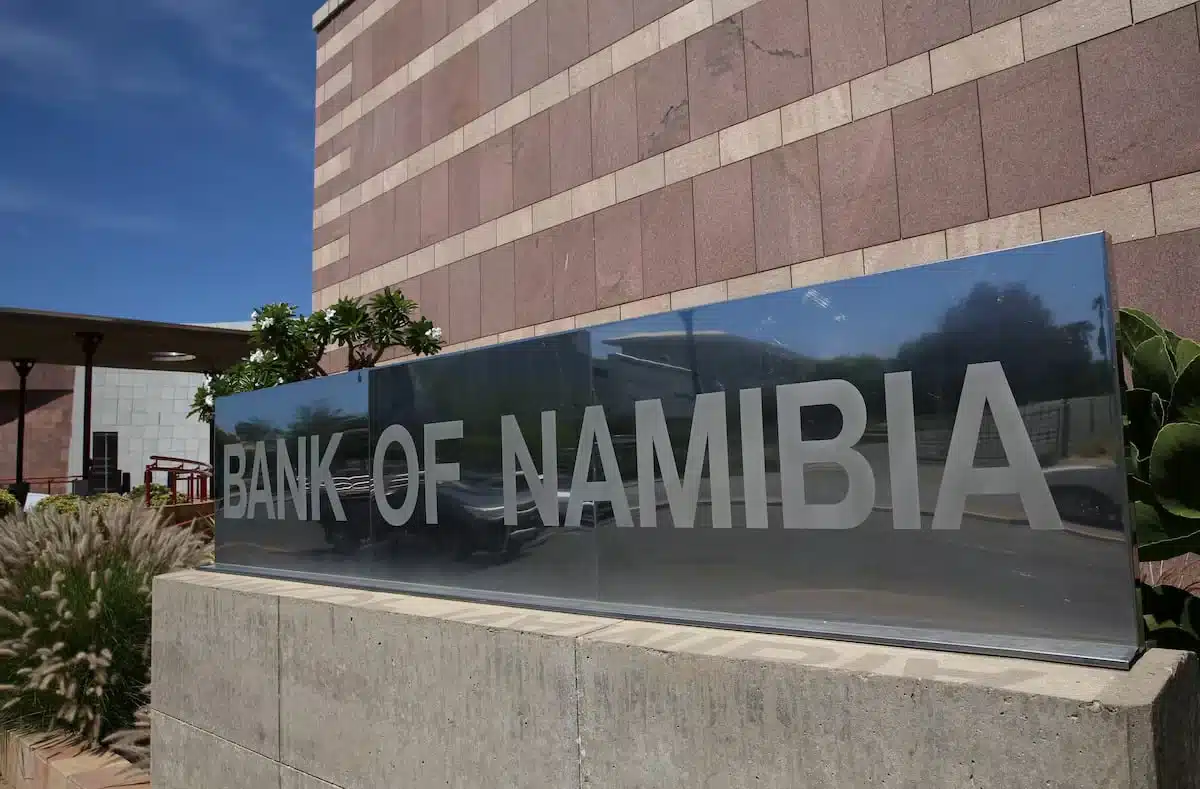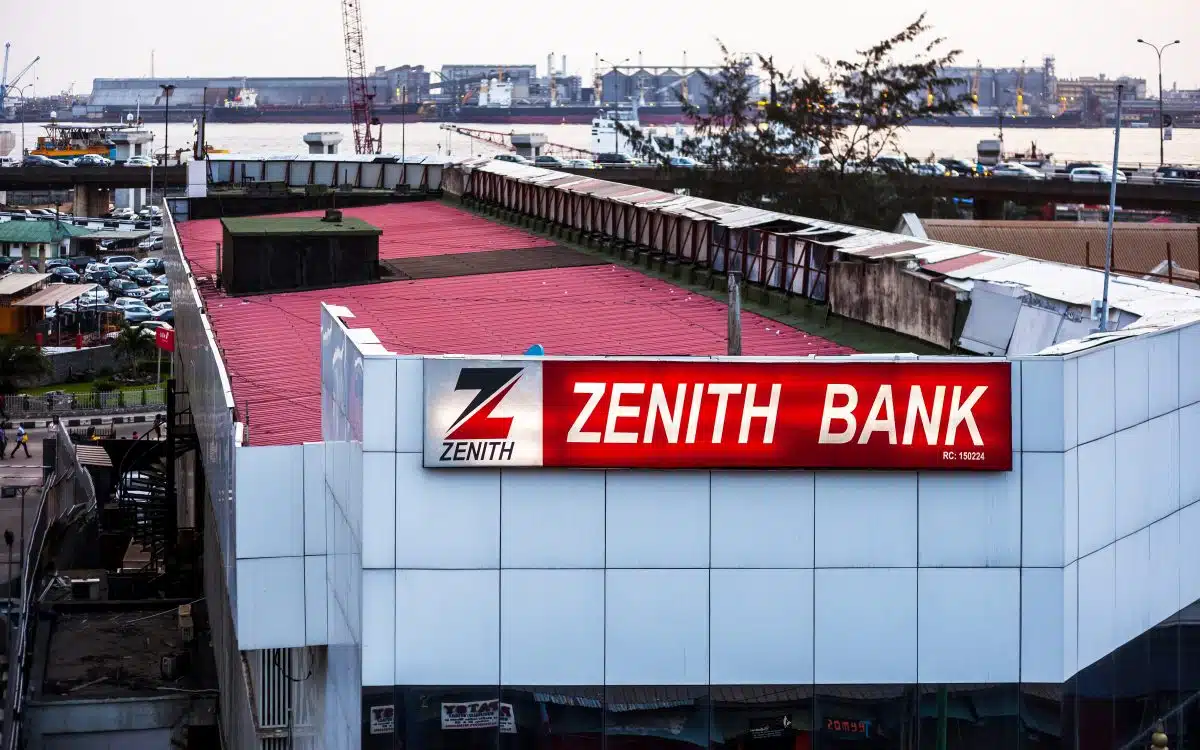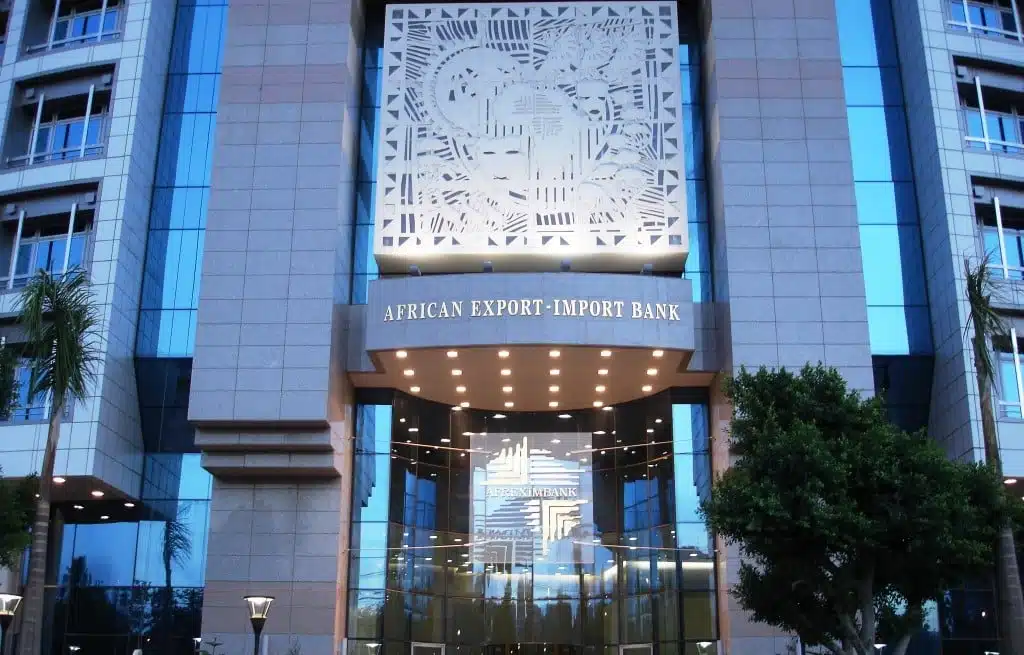The second coming of President Trump has heralded nothing short of a paradigm shift in the global order. Everything from trade, geopolitics, diplomacy, and even international aid and development has felt the whirlwind impact of the United States’ 47th President.
As part of a raft of Executive Orders signed on his inauguration day, the President ordered a 90-day pause in United States foreign development assistance pending a review of its efficiency and alignment with American foreign policy.
The White House claimed that “the foreign aid industry and bureaucracy are not aligned with American interests… and serve to destabilize world peace by promoting ideas in foreign countries that are directly inverse to harmonious and stable relations internal to and among countries.”
In just over two weeks following President Trump’s inauguration, the administration has made known its plan to dissolve the United States Agency for International Development (USAID)—the government body in charge of dispensing the bulk of U.S. foreign aid programs in areas of health, education, and food security/agriculture—or absorb it into the Department of State with a much-reduced workforce, budget, and scope of activities.
There is currently a raging political battle over the constitutionality of Trump and his ally Elon Musk’s plan, with opposition (Democrats) vowing to halt such actions.
While the battle in Washington centres on the legality of Trump’s actions, in many vulnerable regions like Africa, which rely heavily on United States support in areas of health, agriculture, education, and emergencies, the health systems have been exposed.
For example, the decision in Washington, D.C., has created a funding gap in HIV response efforts across Africa and the world, where USAID’s HIV response efforts cost billions annually. Countries like South Africa, Nigeria, Malawi, Lesotho and others who depend on the United States to provide crucial treatment and testing resources for the infected. The World Health Organisation (WHO) put the number of HIV infected people in Africa at 25.6 million with East and Southern Africa accounting for 20.8 million from the total figure.
In 2024, foreign assistance from the United States to Sub-Saharan Africa reached $12.7 billion with Ethiopia being the largest recipient at $1.22 billion followed by the Democratic Republic of Congo (DRC) at $1.27 billion. Other top recipients include Somalia at $826 million, South Sudan ($816 million), Nigeria ($762 million), Sudan ($671 million) and Kenya receiving $647 million.
The United States Agency for International Development (USAID) in the past year disbursed over $6 billion in aid to African countries out of its total $24 billion global disbursement in the year. Somalia was the biggest recipient of the USAID funding in the year receiving just over 10% of the figure at $660 million in the past year.
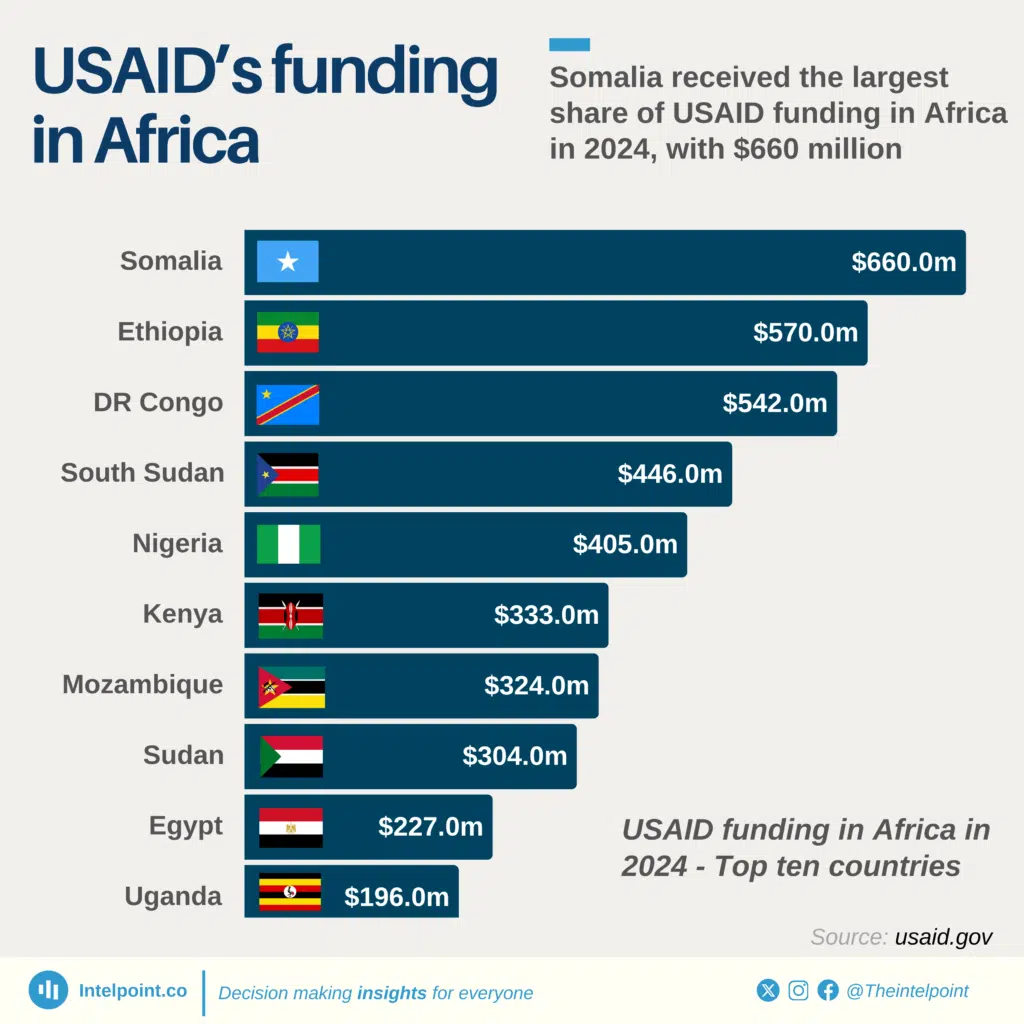
Over 50% of USAID’s funding in Africa were directed to humanitarian assistance and healthcare emphasizing the severe humanitarian crisis plaguing the continent. It is projected that in 2025, around 141 million people across Africa will be needing humanitarian assistance.
A pause in such a crucial source of funding for development initiatives is expected to worsen outcomes in healthcare, education and other sectors of development.
This article will provide the top ten recipients of USAID disbursements to Africa in 2024 and how the halt in funding will impact the livelihoods of people in those countries.
10. Uganda – $196 million
In the past year, USAID disbursed $196 million to this East African nation of which most of the funds were directed to health, humanitarian assistance and agricultural support in the country. In 2024, over a quarter of USAID’s funding ($55.8 million) in Uganda was channeled to the HIV commodities project.
This project involves procurement and delivery of HIV drugs including anti-retroviral (ARV); co-trimoxazole; HIV/syphilis duo, 25 tests (e.g. SD bioline); HIV rapid recency assay and voluntary medical male circumcision (VMMC); sexually transmitted infections/opportunistic infections commodities (STI/OI drugs); sexually transmitted infections/opportunistic infections labour. According to the World Health Organisation (WHO), the number of people living with HIV in Uganda is 1.4 million with women more likely to become infected according to the data.
The agency also expended up to $22 million on emergency food assistance in the country especially for refugees and conflict-affected populations. The pause in funding is expected to worsen humanitarian efforts in the country which hosts the largest number of refugees in Africa and one of the largest in the world. An estimated 1.7 million refugees live in Uganda- mainly from conflict-ridden neighbours like the Congo, South Sudan who face severe risks of disease, violence and abuse.
The World Health Organisation (WHO) has declared an outbreak of Monkeypox and the Ebola Virus Disease (EVD) just last month. The pause on USAID activities in the region would severely undermine response to these deadly outbreaks and if not properly managed could result in a fatal epidemic across the continent.
09. Egypt– $227 million
in 2024, Egypt received $227 million from USAID which was mostly spent on activities relating to governance promotion, culture, media and tourism. Also, humanitarian assistance and agricultural initiatives also featured heavily in the embattled agency’s activities in the country. For example, $14 million was disbursed for a humanitarian assistance project tagged “Egypt for sudan crisis response” while the “The Feed the Future Egypt Rural Agribusiness Strengthening activity” received $8.7 million.
The U.S aid agency also released $6.8 million for integrated monitoring for cultural tourism awards and $6.3 million was for a scholar award program.
Egypt escaped President Trump’s foreign aid freeze mainly over its role in hosting refugees from Gaza although the concessions granted to her and Israel were for military aid.
08. Mozambique – $324 million
this country received $324 million in USAID disbursement in 2024 of which health, humanitarian response and economic development received the most funding by sectors. The U.S agency funded health programs in the period to the tune of $136 million while humanitarian activities funding reached $86 million and economic development programs got $43 million.
HIV/AIDS, Malaria and emergency response programs were heavily funded in the country by USAID. For example, around $94 million was expended in three different HIV/AIDS programs- the Global Health Supply Chain – Procurement and Supply Management, USAID Commodities for Health: Ensuring Guaranteed Access and Reliability (CHEGAR) and AMOSTRA.
According to the United Nations AIDS organisation, the number of people infected with HIV/AIDS in Mozambique in 2023 stood at 2.7 million of which adult women were more infected at 1.5 million. The country has the second highest people living with HIV/AIDS in Africa just after South Africa.
Beyond the response to the health crisis, President Trump’s recent actions on USAID is expected to compound the country’s humanitarian response problem. Conflict in the Cabo Delgado region of the country coupled with two tropical storms that hit Mozambique have affected up to 2.1 million people with over 570 thousand people displaced.
07. Kenya– $333 million
USAID disbursed $333 million to this East African nation of which Humanitarian activities received nearly 50% of the funds at $150 million. This was followed by health and economic development activities which received $143 million in the past year.
The Global Health Supply Chain Procurement and Supply for HIV and AIDS program in Kenya gulped $50 million from USAID while more than $118 million was spent on different emergency food assistance and WASH programs for conflict affected populations in the country. The HIV prevalence rate in Kenya stands at 2.4% which put the total number of persons with HIV at 1.4 million.
The severe humanitarian situation in Kenya stems from devastating floods which affected 40 of the country’s 47 counties leading to over 300,000 displaced people and worsening food insecurity and disease outbreaks like cholera and Mpox.
In a reaction to the U.S temporary freeze of foreign aid, the Kenya Chair of National Treasury- John Mbadi told Journalists that the country will resort to domestic financing to meet its critical health programs like HIV/AIDS, Malaria and others emphasizing that budgets of other sectors might be slashed.
In his words, “We will have no alternative but to slash part of the development budget and use the funds to finance critical programmes that will be starved of cash if the US stops foreign aid,”
“There is no cause for alarm as I have started to put measures in place to ensure that health programmes that depended heavily on foreign aid are not paralysed.”
06. Sudan – $304 million
Disbursements to this country by USAID in 2024 reached $374 million and the bulk of the assistance ($304 million) went to humanitarian relief efforts. Activities relating to program support and democracy, human rights and governance development received $46.8 million.
The ongoing civil war in the country between the Sudanese Armed Forces and the Rapid Support Forces (RPF) began in April, 2023 and has resulted in the largest humanitarian crisis in the world. The country hosts more than 11 million displaced persons and over 3 million have fled to neighbouring countries.
The conflict coupled with devastating floods that hit the country mid last year further compounded the humanitarian crisis. According to the World Food Program (WFP), the prevalence of farming has been confirmed in certain parts of the country and the Integrated Food Security Phase Classification (IPC) in its latest analysis placed Sudan at 5 meaning death by starvation has become a common occurrence.
05. Nigeria – $405 million
Nigeria received $405 million from USAID in the past year with almost half of the funding $193 million going to humanitarian activities. This was followed by health ($136 million), program support ($30 million) and economic development initiatives receiving $22 million.
HIV/AIDS response in Nigeria received the highest funding during the period reaching a combined $109 million for the two biggest projects- the Global Health Supply Chain – Procurement and Supply Management single award IDIQ and Global Health Supply Chain – Rapid Test Kits TO (GHSC- RTKs). The purpose of the GSHC-PSM is to ensure uninterrupted supplies of health commodities and strengthen supply chain systems in Nigeria. The IDIQ has three task orders, one of which directly supports the President’s Emergency Plan for AIDS Relief (PEPFAR).
WASH activities like the Lagos Urban Water Sanitation project and Watershed protection for safe and sustainable water supply received $7 million in funding.
In response to the looming health crisis following Pres. Trump’s January 20th order , the federal government, through the Ministry of Health and Social Welfare, has announced a N4 billion allocation to support HIV response pending the resolution of President Trump’s 90-day order on international aid.
Furthermore, the federal government has formed a committee to sustain USAID-funded health programs composed of officials from finance, health, and environment ministries aiming to secure new funding to ensure continued treatment for HIV, tuberculosis, and malaria patients.
04. South Sudan – $446 million
Over half of the $446 million spent by USAID in South Sudan went to humanitarian activities. Peace and Security programs received $35 million while education and social services got $21 million.
The significant humanitarian assistance received by the country from USAID stems from the internecine clashes between communities and groups, food insecurity and climate change, public health problems and climate change related issues. The United Nations ranks South Sudan as the second most vulnerable country to natural disasters in the world and the conflict in its former Sudan has added salt to its injury from the humanitarian crisis.
The country currently hosts nearly a million displaced persons from Sudan and the figure is expected to increase this year.
03. Democratic Republic of Congo (DRC) – $542 million
Like other conflict-ridden countries in the continent, much of USAID’s $542 million funding in this country was directed to humanitarian assistance at $369 million Projects include; emergency food and nutrition assistance, agriculture, water sanitation, hygiene and economic recovery.
Funding for health-related programs in D.R Congo from USAID was $70 million and the HIV/AIDS global health supply chain program.
The temporary halt of USAID activities and threat to dismantle the agency is bad news for aid workers and humanitarian activities in the Congo. The policy coincides with recent conflict in the country as M23 rebel fighters captured the city of Goma in the Northern part of the country. The United Nations estimate that around 3,000 people have been killed in the conflict after the renewed conflict.
02. Ethiopia– $570 million
Over $570 million was disbursed by USAID of which $381 million went into humanitarian activities. The country in the last two years has seen climate-related floods, and conflicts in some of its regions. Some 4.6 million people in the country relied on monthly food distribution on average according to the United Nations.
In 2025, the Ethiopian government and humanitarian partners plan to assist 10 million people, requiring an estimated $2 billion in funding but insecurity remains a bottleneck to humanitarian efforts in conflict zones of the country.
01. Somalia – $660 million
USAID disbursed $660 million worth of various forms of aid to Somalia making her the largest recipient of USAID funding in 2024. However, the bulk of the spending was directed to humanitarian assistance work at $558 million. In 2024, around 6.9 million people in the country needed some form of humanitarian assistance but the figure is expected to drop in 2025 to 5.9 million.
The humanitarian crisis in the country was exacerbated by the floods which affected up to 2.4 million people and resulted in water diarrhoea and cholera outbreak.
Besides activities by the United States Agency for International Development in providing aid to African countries, other U.S. government agencies also carry out similar work, whose activities have been affected by the “Reevaluating and Realigning United States Foreign Aid” Executive Order of January 20, signed by President Trump.

